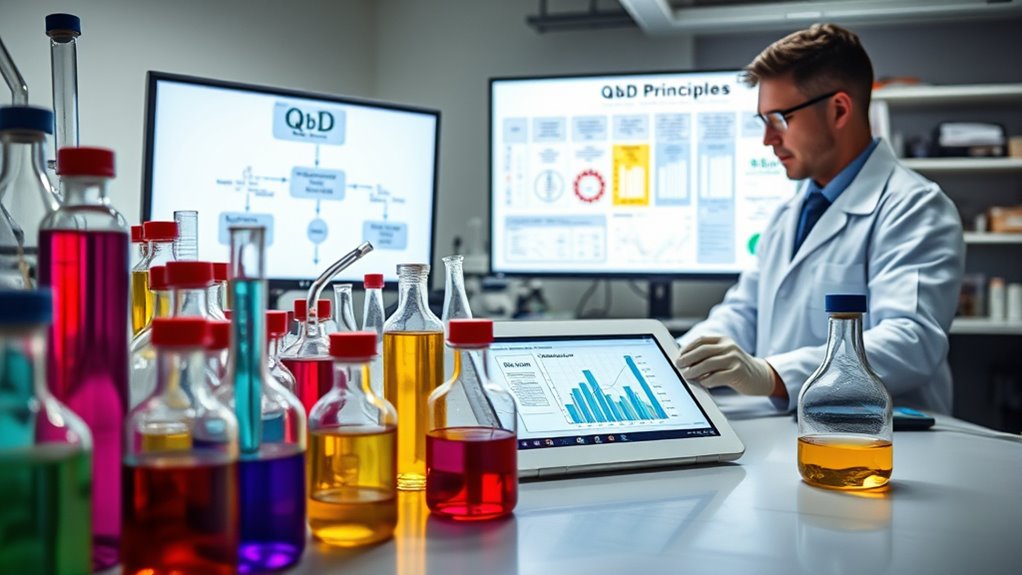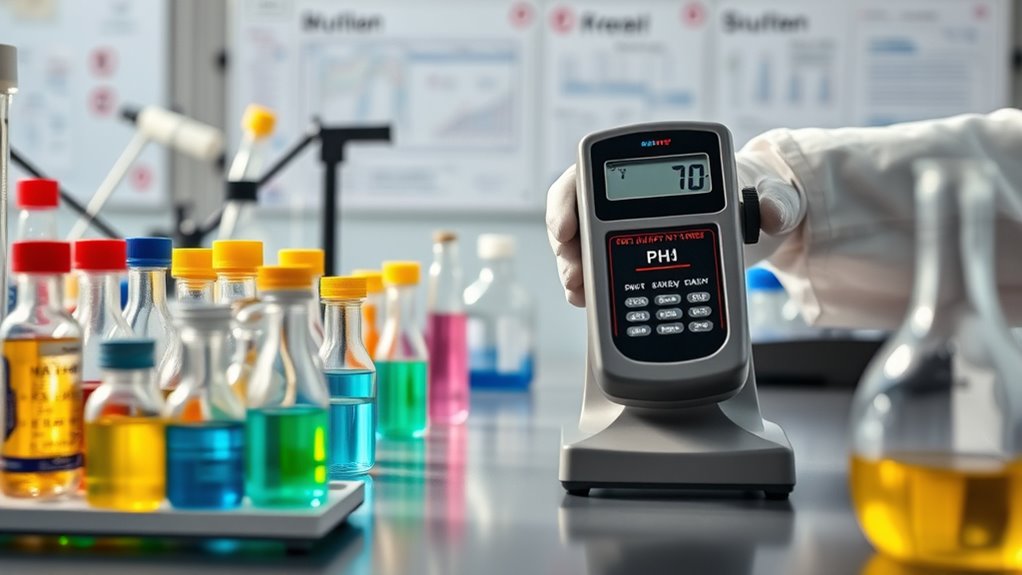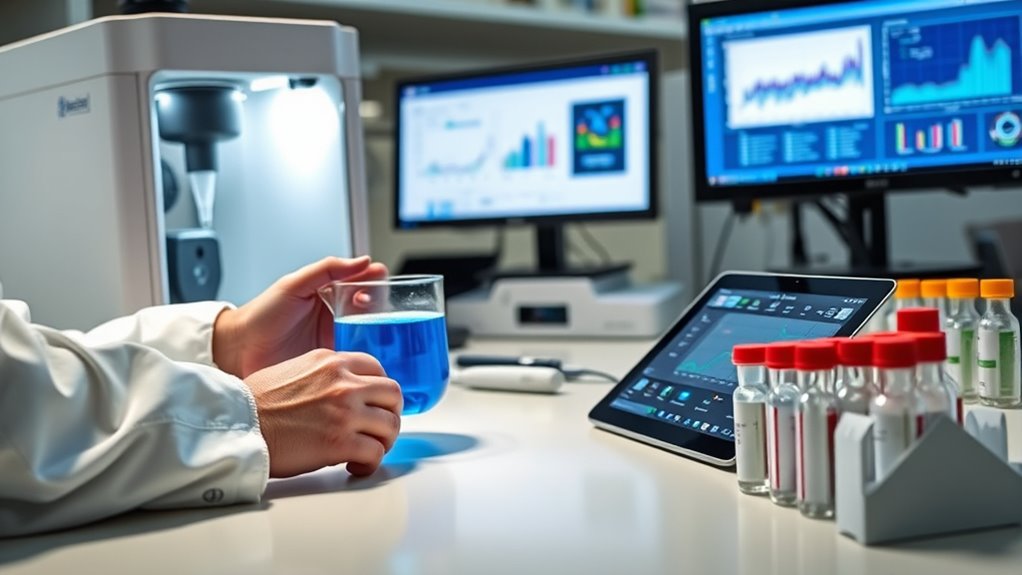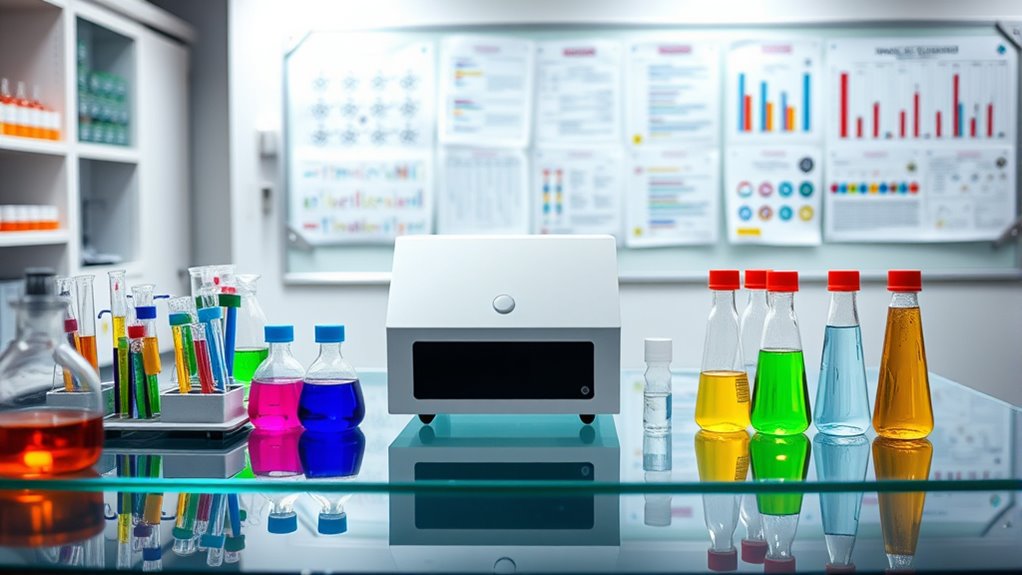Applying Quality by Design (QbD) principles to analytical method development helps you create robust, reliable, and compliant procedures. Start by defining clear objectives through the Analytical Target Profile, then identify critical quality attributes and risk factors. Use systematic tools like design of experiments (DoE) to optimize conditions and control variability. This approach aligns testing with specific use, supports regulatory standards, and promotes continuous improvement—if you continue, you’ll gain deeper insights into mastering QbD in your methods.
Key Takeaways
- QbD in analytical methods emphasizes a systematic, science-based approach to ensure consistent performance aligned with predefined objectives.
- It involves defining the Analytical Target Profile (ATP) and identifying critical quality attributes (CQAs) for method robustness.
- Risk assessment tools like FMEA and design of experiments (DoE) are used to optimize critical method parameters (CMPs).
- Lifecycle management and continuous monitoring are integral to maintaining method reliability and regulatory compliance.
- Incorporating quality risk management and advanced analytical techniques helps address variability and technical challenges effectively.
Fundamental Concepts of QbD in Analytical Methods

Fundamental concepts of QbD in analytical methods revolve around a systematic, science-based approach that guarantees your method consistently meets its intended performance. You start by defining clear objectives, often through a Quality Target Product Profile (QTPP), which sets measurable goals like accuracy, precision, and robustness. This approach emphasizes a thorough understanding of the method’s critical factors to ensure quality outcomes.
This helps you understand critical quality attributes and the risks that could impact performance. Using tools like risk assessment and design of experiments (DoE), you identify and control critical method parameters (CMPs), ensuring your method is reliable. Incorporating a robust process mindset allows for better handling of variability and enhances method reliability. Additionally, understanding the critical factors that influence method performance is essential for developing a resilient analytical process. Recognizing the importance of process robustness can further improve the method’s ability to perform consistently under different conditions.
Establishing a design space allows you to operate confidently within validated parameters, reducing variability. Throughout the lifecycle, you continuously monitor and improve your methods based on data, maintaining consistent quality and performance under varying conditions.
Essential Principles Guiding AQbD Implementation

Implementing AQbD effectively requires a clear understanding of its guiding principles, which focus on aligning analytical performance with the intended use. You start by defining method requirements based on specific needs, then evaluate performance metrics like specificity, sensitivity, and accuracy. Incorporating natural materials into method development enhances robustness and authenticity. Recognizing the significance of emotional support in the development process can improve team collaboration and decision-making. Incorporating Quality Risk Management helps you identify and control sources of variability, ensuring robustness. You develop control strategies to maintain consistency and monitor performance throughout the method’s lifecycle. Regulatory guidelines from FDA, USP, and ICH support these principles, providing frameworks for implementation. Emphasizing a lifecycle approach, you continuously improve methods through feedback and updates. Collaboration with regulatory bodies and industry partners fosters knowledge sharing and training, reinforcing a culture of quality by design. Recognizing the importance of method validation ensures that analytical procedures meet regulatory standards and performance criteria. These principles establish a solid foundation for reliable, compliant analytical procedures.
Step-by-Step Workflow for Developing Robust Analytical Procedures

Developing robust analytical procedures involves a systematic workflow that guarantees the method meets its intended purpose reliably. Start by defining the Analytical Target Profile (ATP) to specify requirements like accuracy, precision, sensitivity, and specificity. Conduct a risk assessment to identify variables that could impact performance, using tools like FMEA. Next, design experiments with a structured approach such as Design of Experiments (DoE) to optimize conditions. Clearly define Critical Quality Attributes (CQAs) and parameters, focusing on key characteristics like resolution and peak capacity. Proceed with method optimization to achieve ideal conditions for robustness. Incorporate considerations for method safety and quality to ensure compliance with safety standards and material safety. Throughout, utilize tools like data analysis software and control strategies to ensure consistency. This organized approach helps you develop reliable, compliant, and high-performing analytical procedures aligned with QbD principles.
Overcoming Challenges and Navigating Regulatory Expectations

Understanding the complexities of analytical method development requires you to address both technical challenges and regulatory expectations proactively. Biopharmaceuticals’ intricate molecules can complicate analysis, so optimizing recovery, ensuring analyte stability, and managing matrix interference are essential. Incorporating high-quality projector technology can improve visualization during data review and validation processes. Additionally, employing advanced analytical techniques can help identify subtle impurities and enhance method robustness.
Proactively address technical challenges and regulatory expectations in analytical method development for biopharmaceuticals.
Extended timelines mean you must stay adaptable, updating and revalidating methods as needed. Steering regulatory demands involves aligning with frameworks like GMP, meeting standards from agencies like the FDA, and maintaining comprehensive documentation.
Preparing for audits and inspections is crucial. To succeed, develop a deep process understanding, define a robust design space, and utilize statistical tools such as Design of Experiments (DoE).
Collaborate across teams, continuously assess risks, and implement quality controls. These strategies help you overcome technical hurdles and meet regulatory expectations effectively.
Practical Examples Demonstrating QbD in Analytical Techniques

Practical examples vividly illustrate how Quality by Design (QbD) principles enhance analytical techniques in real-world settings. For instance, in impurity analysis of ziprasidone, applying DoE helped identify critical variables, resulting in a robust, reliable method.
In complex pharmaceutical environments, QbD guarantees compliance with GMP standards by developing adaptable methods that maintain performance across different conditions.
For cold and cough formulations, AQbD optimized analytical procedures using systems like Arc Premier, addressing challenges such as analyte stability and recovery.
Additionally, QbD tackles sample preparation issues, improving automation and accuracy.
In the realm of Audi Tuning, applying QbD principles can lead to more consistent and optimized modifications tailored to specific models and driving preferences.
Continuous data-driven refinements enable methods to stay effective over time, ensuring consistent quality.
These examples demonstrate how integrating QbD principles leads to more robust, compliant, and efficient analytical techniques in diverse pharmaceutical settings.
Frequently Asked Questions
How Does AQBD Differ From Traditional Method Validation Approaches?
You might think traditional validation focuses on testing a method to meet set criteria, but AQbD takes a different approach. It builds quality into the method from the start, using risk assessments, design of experiments, and defining a design space.
This guarantees robustness, flexibility, and continuous improvement throughout the method’s lifecycle, rather than just verifying performance after development. AQbD promotes proactive management over reactive validation.
What Tools or Software Facilitate AQBD Implementation in Laboratories?
You can use various tools and software to facilitate AQbD implementation in laboratories, such as Design of Experiments (DOE) programs like MODDE®, which help you systematically identify key factors affecting product quality.
Risk management tools like FMEA software enable you to prioritize risks, while integrated laboratory data platforms streamline data collection and monitoring.
Additionally, process analytical technology (PAT) software supports real-time data analysis, ensuring robust method development aligned with AQbD principles.
How Can Small Organizations Effectively Adopt AQBD Principles?
You can effectively adopt AQbD principles by focusing on high-impact methods and using simple, cost-effective tools. Prioritize critical parameters early, utilize small-scale experiments, and leverage existing data and literature to guide development.
Collaborate with external experts or academic institutions for knowledge, and implement routine monitoring to guarantee continuous improvement.
Training staff gradually and documenting lessons learned will help embed AQbD into your organization’s culture, even with limited resources.
What Are Common Pitfalls When Applying AQBD in Analytical Method Development?
Think of applying AQbD like sailing a ship through unpredictable waters. Your common pitfalls include neglecting clear objectives, which leaves your ship off-course, and skipping robustness tests, risking leaks.
Insufficient documentation and inadequate training are like faulty navigation tools, causing errors.
Time pressures and limited resources can make the journey even rougher.
Without proper alignment and thorough validation, your voyage might face regulatory storms, threatening to sink your method’s success.
How Does AQBD Influence Regulatory Submissions and Approval Processes?
Your regulatory submissions benefit from a systematic approach that improves process understanding and control. By clearly demonstrating your method’s robustness and risk management strategies, you build confidence with authorities.
This can lead to faster approvals, greater flexibility in manufacturing, and easier post-approval changes. You also show compliance through thorough documentation, reducing uncertainty and strengthening your case.
Ultimately, this approach streamlines the entire approval process.
Conclusion
By embracing QbD principles, you turn analytical method development into a proactive journey rather than a reactive task. It’s like planting seeds for consistent quality and reliable results, ensuring your methods flourish under scrutiny. With a clear understanding of these principles, you’ll master the art of designing robust procedures that stand the test of time. So, why settle for good enough when you can craft excellence—because in QbD, precision isn’t just an option, it’s your destiny.








